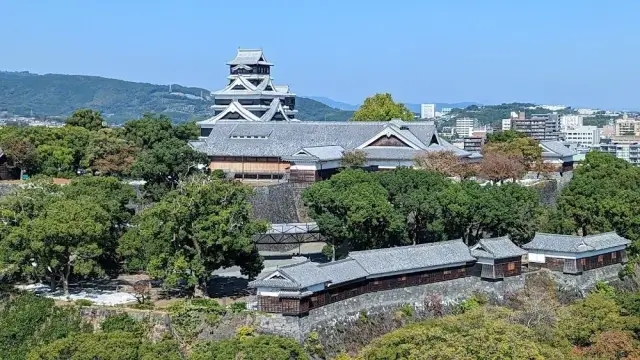https://www.dekitabi.com/itinerary/kumamoto-city-essential-tour
Kumamoto, a city renowned for its rich history and captivating landscapes, offers an array of must-see attractions that weave together the cultural tapestry of Japan. Among these treasures are Suizenji Jojuen Garden, Kumamoto Castle, Inari Shrine, and Honmyoji Temple. Each site provides a unique glimpse into Japan’s past and its scenic beauty.
Suizenji Jojuen Garden: A Tranquil Oasis

https://www.dekitabi.com/attraction/suizenji-jojuen-garden
Suizenji Jojuen Garden, often referred to simply as Suizenji Garden, is a quintessential example of a traditional Japanese landscape garden. Located in the heart of Kumamoto, this serene park is a masterpiece of landscape design, reflecting the artistic sensibilities of the Edo period.
Established in the early 17th century, Suizenji Jojuen Garden was originally created as a private garden for the Hosokawa clan, one of the influential samurai families of the time. The garden is renowned for its meticulously designed landscape, which includes a picturesque pond, manicured lawns, and a stunning array of seasonal flowers.
One of the garden’s most striking features is its 1/100th scale replica of Mount Fuji, crafted from carefully arranged rocks and vegetation. This miniature version of Japan’s iconic mountain offers visitors a unique opportunity to appreciate its beauty without leaving the garden. Strolling along the garden’s pathways, guests can enjoy the tranquil environment and marvel at the harmonious blend of natural and man-made elements.
Kumamoto Castle: A Fortress of History and Resilience

https://www.dekitabi.com/attraction/kumamoto-castle
Kumamoto Castle, an iconic symbol of the city, stands as a testament to Japan’s feudal past and architectural prowess. Built in the early 17th century by the powerful Hosokawa clan, this imposing structure is renowned for its sophisticated design and formidable defenses.
The castle’s construction was a feat of engineering, featuring advanced stonework and an elaborate system of moats and walls. Its towering keep, or donjon, rises above the surrounding landscape, offering breathtaking views of Kumamoto and its environs. The castle’s black walls and elegant curves make it a striking example of Japanese military architecture.
Visitors to Kumamoto Castle can explore its expansive grounds, including the inner and outer baileys, and the impressive turrets that once served as defensive fortifications. The castle’s interior houses a museum that provides insight into its history and the significant events that shaped its legacy. Although the castle has undergone extensive restoration due to damage from earthquakes in recent years, it remains a resilient symbol of Kumamoto’s heritage.
Inari Shrine: Spiritual Tranquility

https://www.dekitabi.com/attraction/kumamoto-castle-inari-shrine
Inari Shrine, nestled in the vicinity of Kumamoto Castle, is a place of spiritual significance and natural beauty. Dedicated to Inari, the Shinto deity of agriculture and fertility, the shrine is renowned for its vibrant torii gates and serene atmosphere.
The shrine’s approach is lined with rows of red torii gates that create a visually striking and spiritually uplifting pathway. These gates, donated by individuals and businesses, symbolize prosperity and success. As visitors walk through the gates, they are enveloped in a sense of peace and reverence, making it a perfect spot for reflection and prayer.
In addition to its architectural beauty, Inari Shrine is surrounded by lush greenery and offers picturesque views of the surrounding landscape. The shrine’s grounds are also home to various smaller shrines and statues, each contributing to the overall sense of tranquility and spiritual depth.
Honmyoji Temple: A Historic Sanctuary

https://www.dekitabi.com/attraction/honmyoji-kumamoto
Honmyoji Temple, a significant Buddhist temple in Kumamoto, is renowned for its historical and cultural importance. Established in the early 17th century, the temple is a prominent example of traditional Japanese temple architecture and design.
The temple complex features a grand main hall, or hondo, which houses an impressive collection of Buddhist statues and artifacts. The intricate woodwork and serene ambiance of the hall create a reverent atmosphere for visitors. The temple’s gardens, with their meticulously arranged rocks and tranquil ponds, enhance the sense of peace and spiritual reflection.
Honmyoji Temple is also known for its role in local festivals and cultural events, which provide visitors with an opportunity to experience traditional Japanese customs and practices. The temple’s historical significance, combined with its architectural beauty and serene environment, makes it a compelling destination for those interested in Japan’s spiritual heritage.
Experience the Charm of Kumamoto
Kumamoto’s rich history and cultural heritage are beautifully showcased through its landmarks. Suizenji Jojuen Garden offers a peaceful retreat with its classic Japanese garden design, while Kumamoto Castle stands as a powerful symbol of historical resilience. Inari Shrine provides a spiritual sanctuary, and Honmyoji Temple invites visitors to explore its historical and cultural depth. Each site contributes to a comprehensive understanding of Kumamoto’s unique charm and enduring legacy.
Exploring these landmarks provides a deeper appreciation of Japan’s cultural and historical landscape, making Kumamoto a must-visit destination for those seeking to immerse themselves in Japan’s rich heritage.


Leave a Reply